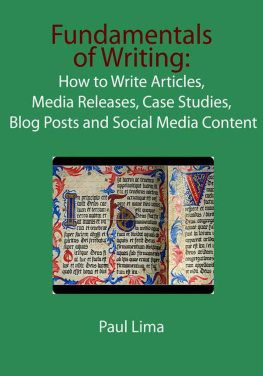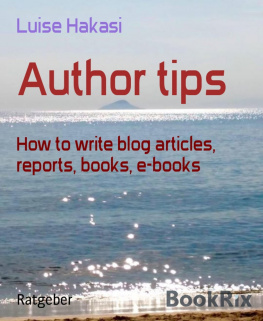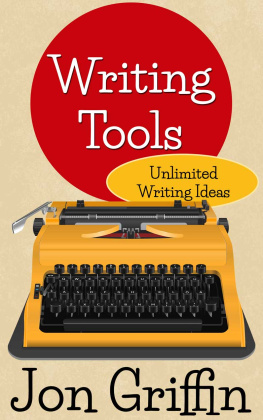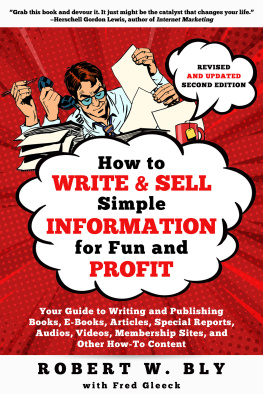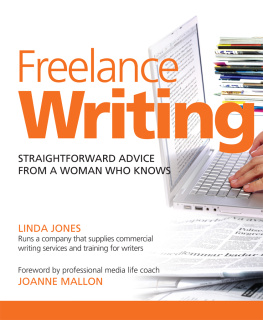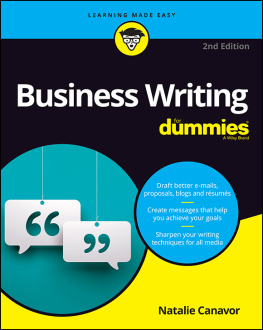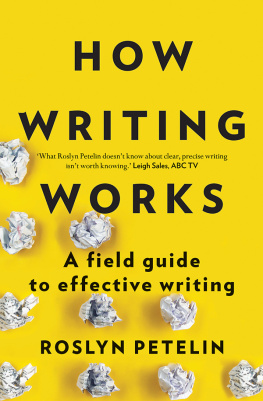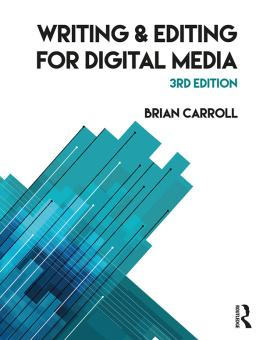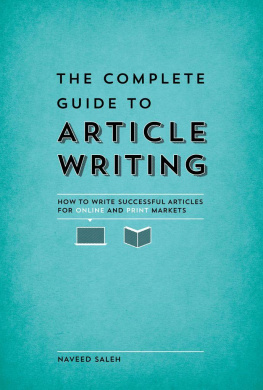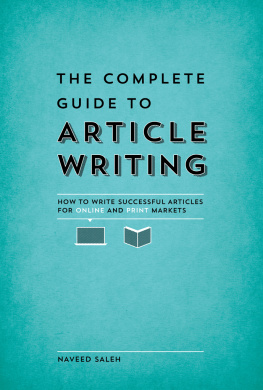Fundamentals of Writing:
How to Write Articles,
Media Releases, Case Studies, Blog Posts and
Social Media Content
Paul Lima
F undamentals of Writing : How to write articles, media releases, case studies, blog posts and social media content - First Edition 2013
Published by Paul Lima Presents
Published in Canada
All rights reserved. No part of this publication may be reproduced, stored in or introduced into a retrieval system, or transmitted in any form or by any means (electronic, mechanical, photocopying, recording or otherwise), without the prior written permission of both the copyright owner(s) and the above publisher of the book.
ISBN: 978-1-927710-02-9
I ntroduction
1 The Importance of Creativity
2 Communication Process
3 Pleased to Meet You
4 The Writing Process
5 Outline Before You Write
6 The Three Cs of Writing
7 Before Writing Articles
8 Overview: Types of Articles
9 Writing Article Leads
10 Full News Articles
11 Soft Articles and Leads
12 Feature Articles and Leads
13 Writing Media Releases
14 Writing Case Studies
15 Social Media
16 Writing Blog Posts
17 Constructing Sentences
18 Paragraphs and Transitions
Appendix I: Full Articles
Appendix II: Case Study
About the Author
W elcome to Fundamentals of Writing , a book written specifically for those who want to improve their writing skills and apply them to writing articles (for newspapers, magazines, corporate and other publications), media releases, case studies, blog posts and social media content. The book is based on several writing courses that I teach online for University of Toronto continuing education students and for private students and corporate clients.
Fundamentals of Writing is for you if you are looking to
- become a more effective writer;
- organize your thoughts before you write;
- write for a defined audience;
- make your points in a clear, concise, focused manner.
If you are like me, you fear the blank screen or blank page. You look at it and feel intimidated. You see it as an empty vessel you have to fill with wordsonly you are not quite sure which words to use, how to order them or how to use all those squiggles (known as punctuation marks).
Perhaps you are not like me. Perhaps you love the sight of a blank page. You view it as a blank canvas, an opportunity to create. However, you may feel your creations take too long to come to fruition. You start, you stop, you start again. Moving forward is a slow, painful journey, and you often feel you've missed your mark or destination, even if just by a tad, when you are done.
Welcome to the wonderful world of writing.
My hope is that this book will help you overcome that feeling of intimidation. And if you don't feel intimidated by the blank page, that's cool. My hope is that the book will simply help make you a stronger, more confident, writer. In both cases, the hope is that this book will help you write in a more focused and concise manner, and will help you effectively structure your written communication when writing articles, media releases, case studies, blog posts and social media content.
Although the book covers writing stronger sentences and more organized paragraphs in the last couple of chapters, it does not cover spelling or grammar or how to write advertising or promotional copy, business documents (email, letters and reports) or how to write for the web. (Visit www.paullima.com/books for books on most of those topics.)
When it comes to the fundamentals of writing, this book will get you grounded and focusedespecially if you feel as if you're often spinning your wheels when you write. Fundamentals of Writing focuses on the writing process to get you thinking about your audience, purpose and desired outcome before you start to write. Then it helps you effectively and efficiently write well-structured, focused documents in a clear, concise manner. You will come to understand the importance of following that process no matter what you are writing because, simply put, writing is a process. To improve your writing, you need to understand the process and apply it in a dedicated and disciplined manner. Exercises in this book will help you apply the process to the types of writing previously mentioned.
The book will also help you spark your writing creativity and exercise your writing muscles, to get them into shape before you start to plunge into writing projects. And, as mentioned, there are a couple of practical chapters toward the end of the book that will help you improve your sentence and paragraph structure, should you need some help with your writing at that level.
Note: This is the first edition of the book. The book should be 99.5% error-free. If, however, you like to play "spot the tpyos," feel free to let me know if you find any, or have any other comments about the book. Email .
Paul Lima
www.paullima.com
1. The Importance of Creativity
W riting is considered an art by most fiction writers, one that involves a great deal of creative thought. For the rest of usthose who write business documents, articles, case studies, media releases, blog posts, social media content, web content and even non-fiction bookswriting is a craft. However, even crafts involve at least a modicum of creative thinking, some types of non-fiction writing more than others, admittedly. Technical competency and understanding the structure of the document you are producing are important; however, unless you are producing a price list, it is difficult to imagine writing without a degree of creative ability.
With that in mind, we are going to look at some creative techniques and do several creative exercises that you may be able to apply to your writing, or at least use to loosen up before you start to write. But before we look at creativity and writing, let's look at something that can interfere with creativity, or what I call your internal critic or censor.

